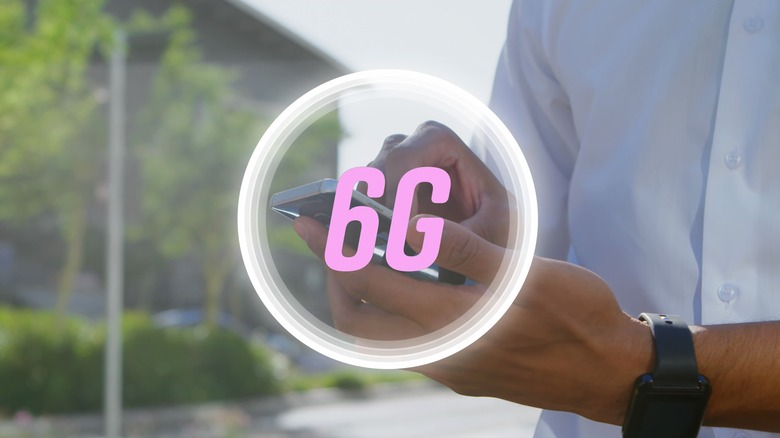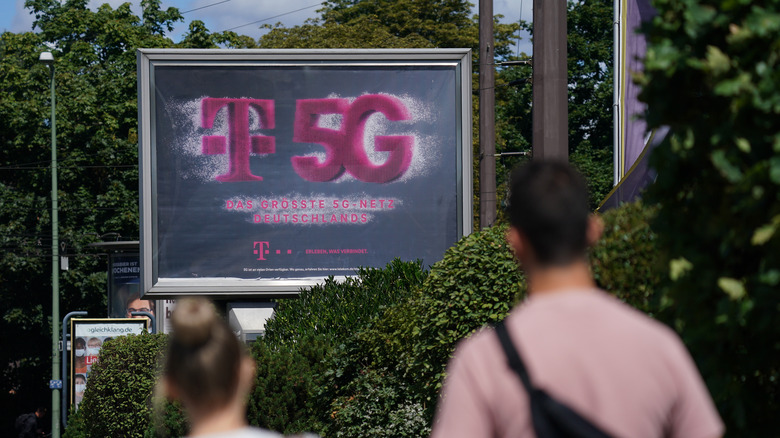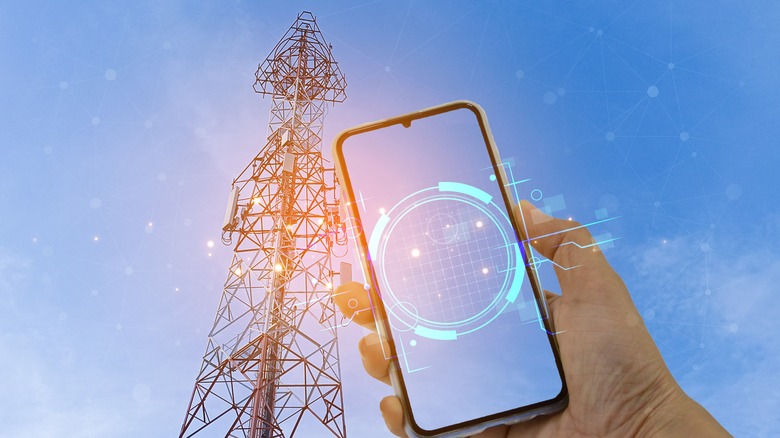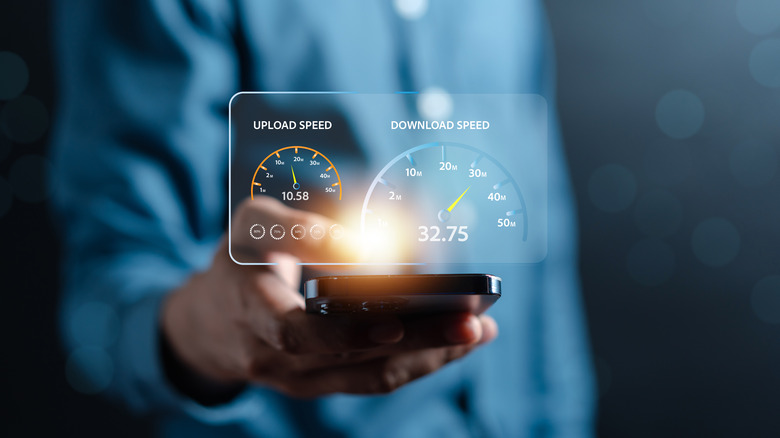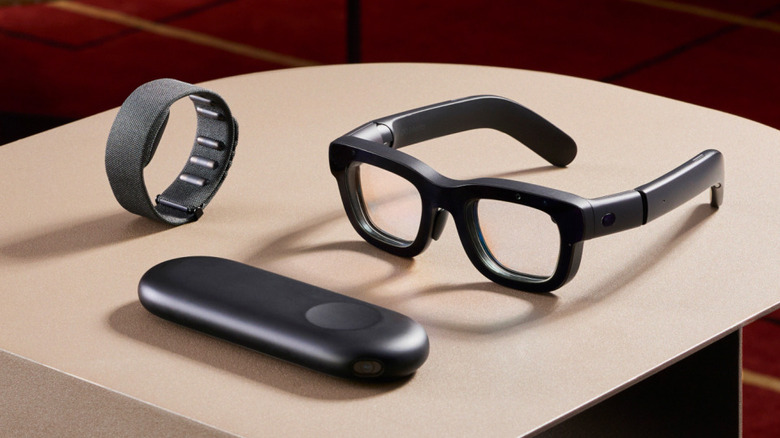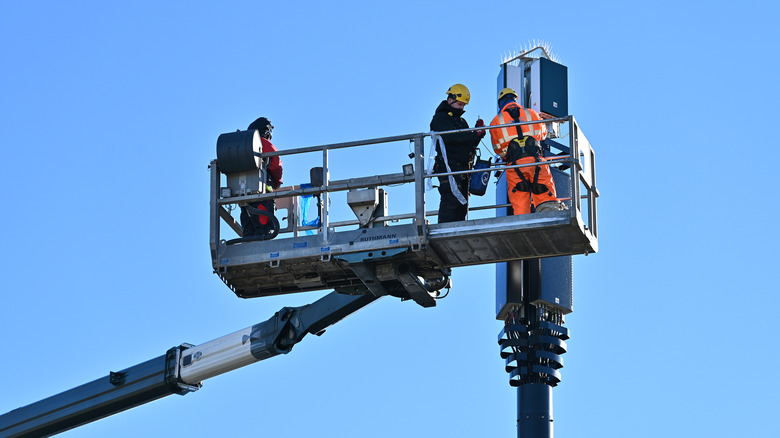Everything You Need To Know About The Future Of 6G Data
The rollout of 5G was supposed to be a bang, but stretched slowly across major metro areas like a flash in the pan. Everyone had to upgrade their phone to one that supports 5G, and then there was that awkward phase where cellphone networks were shutting down 3G devices and dropping support for 4G-capable phones to get customers to buy new ones. What did society get for the trouble? A data setting you're more likely to disable or limit to save battery life. News of the upcoming 5G Advanced suggests this half-baked standard needed a few more years in the oven. True to form, a tech industry built on hype is already talking about 6G before 5G is even finished.
What is 6G? Put simply, it is the successor to the 5G standard, and there's a good chance you've seen mention of it in your newsfeed or your social media scroll. Here's a quick and comprehensive dive into the next generation of mobile data. Here's everything you need to know about 6G.
Why replace 5G?
First, it's important to understand that 5G and 6G are just regular, planned iterations of an improving data standard that started with 1G in 1980. Roughly every 10 years, we upgrade to a new one. It's a lot like how Wi-Fi 6 recently upgraded to Wi-Fi 7. In addition to being faster than the previous version, 5G was supposed to provide better bandwidth, lower latency, better energy efficiency, and most importantly, support more endpoints to keep our growing world of IoT devices running smoothly.
Unfortunately, the reality is not as ideal. Cell carriers haven't yet finished their 5G networks, resulting in spotty coverage and speeds well below the anticipated 20 Gb/s maximum we were promised. This means 5G tends to drain your battery faster. The shorter wavelengths (which struggle to penetrate buildings) coupled with fewer transmitters means your phone guzzles down energy trying to stay connected, especially when you leave the big cities where 5G networks are the strongest. Ironically, disabling 5G (or faster versions, like 5G+) will save your battery without a massive degradation in speed and performance.
Painfully low may be just a matter of giving cell networks time to build it out, but according to Deloitte, more than half of smartphone users feel that their phone isn't making the most of 5G. The experience is better, but the highfalutin aspirations of tech bros were a bust. 6G has the potential to be better than 5G, and may solve some of its biggest issues.
6G vs. 5G
So, what does 6G do that justifies an upgrade from a problematic 5G? According to the Department of Homeland Security, a decent amount, aside from the obvious promises of a speed boost. It will be easier to scale, more reliable, and use more of the radio spectrum. Connections should be more stable, with fewer drops. It will also support the seamless use of multiple connection types at once. So, your cellphone can lean more on nearby Wi-Fi while 6G is weak, without surrendering that connection entirely. Perhaps most importantly, 6G will have the bandwidth and speed to facilitate our ever-more-connected world, wherein millions upon millions of devices are interfacing and shifting around zettabytes (read: an incomprehensibly large amount of data) of information. There's also a great deal of talk about AI-enabled networks, featuring stronger security and better optimization.
It's important to state here that 6G is deep in its research phase, according to Nokia CEO Sigve Brekke. Much like how smartphones lately are only making incremental improvements each year, 6G is very likely to be only a marginally better experience compared to existing 5G. So don't come away from this article thinking 6G will have you living in a "Minority Report" future. Not even the experts know what the final version of 6G will look like; it's all speculation, at least for the time being. Let's take a closer look at each potential benefit one by one.
Speed
Perhaps the most enticing prospect of 6G is just how much faster it will be than its predecessor. Again, it's early in the research phases, but already the test runs of fledgling 6G technology are promising. A recent study by University College London pulled off a 938 Gb/s Ultra-Wideband transmission, or almost 1 Tb/s (terabit). If that number sounds meaningless to you, then think about it another way: you could download a 4K movie in less than a second.
According to the GSA, these speeds could be possible for 6G with the help of upper midband and sub-terahertz bands — in layman's terms, a much wider swath of the spectrum than 5G's fairly congested frequency range. It appears that the upper midband would be the high performance one, giving the fastest speeds in urban areas with lots of transmitters; sub-terahertz would provide more comprehensive coverage, perhaps solving 5G's issue of limited range. Again, it's important to remember that this is currently only theoretical; the aforementioned study was not a demonstration of 6G proper, but rather an exploration into the technologies that engineers may eventually standardize.
Low latency
Speed is great, but a responsive network often proves to be the most noticeable. Low latency is a term bandied about mostly by the gaming community because, well, you can't pull off a 360° no-scope in Fortnite if there's too many milliseconds of delay between the game server and you. Low latency can make everyday Internet browsing and video calling feel a lot snappier and smoother — especially if you are connected to a VPN, which already slows down your connection a little bit. 6G could feature uniquely low latency that might rival some wired and Wi-Fi networks.
One of 6G's promises is refining the URLLC (Ultra-Reliable Low-Latency Communication) standard. Latency could become sub-millisecond; in other words, latency of only a couple milliseconds or less. Extreme estimates put the latency at 10 to 100 µs (microseconds). There are 1,000 microseconds in a millisecond, and 1,000 milliseconds in a second, to give you an idea of what that means.
That is shockingly low when you consider that 5G networks rarely get less than 50 ms of latency. Even if 6G can't pull off it's a lofty 10 µs goal, people will certainly take note of having 1-5 ms of latency. 20 ms is an already attainable on home networks (and a pretty good latency to have), so imagine having a fraction of that on your cellphone, away from home.
Increased bandwidth
High speed and low latency are great, but bandwidth is just as important of a component. You could have all the speed and low latency in the world, but with poor bandwidth, it wouldn't mean as much. As an example, Wi-Fi speed on a laptop can suffer if there are too many devices connected to the same 5 GHz band; the 2.4 GHz band has a higher bandwidth supporting more devices, even if speeds aren't as fast. The same applies to cell networks where having too many concurrent users in a small geographic area can degrade performance, including if they are using 5G. Naturally, the next generation with 6G aims to fix that.
That same study from before where researchers achieved blistering fast speeds included improvements in bandwidth. According to the UCL researchers themselves, their technique would "allow more people to use the network in densely populated urban environments or at large event like concerts without experiencing slowdown, or provide the same number of users with much faster speeds." We may also see cell networks evolve to incorporate mesh network technology, which should theoretically better load-balance networks so slowdowns are even less likely to happen.
Energy efficiency
Energy efficiency in the modern era is a big deal with the growing impacts of climate change. Cryptocurrency made headlines when it was learned that a single Bitcoin transaction took more energy than several hundreds of thousands of Visa transactions (via Statista). Environmental activists are now putting the feet of AI generators over the fire given how much energy it takes to generate a single image. So the question is this: does society have to give up sustainability to get a faster, better performing 6G network? That question is impossible to answer definitively this early in the game, but Nokia Bell Labs has an optimistic outlook.
According to the organization, sustainability is one of the main focuses while developing 6G. It will be a massive undertaking, but Nokia suggests that the goal is to cut 5G power consumption in half while delivering 10 times the capacity — a lofty aim, but one it believes is possible. The group published a whole white paper on how this could be achieved. Aside from a redesign of the physical hardware the network is running on, there is the potential for AI to intelligently optimize the system; so instead of having the network run at full tilt 24/7, it can dynamically shift up and down and consume only as much power as it needs in the moment.
Increased security
The future of warfare is here, except instead of it being lightsabers and gravity shields, it's bots and AI hacking tools. Cyberattacks are now as big of a concern as missile launches and invasions. Our cell infrastructure thus becomes a prime conduit to launch an attack. Hackers can already hijack your cell phone number and receive texts and calls without you knowing, as demonstrated by a recent Veritasium video. Data networks, of course, present a much juicier prize for obvious reasons. Our whole lives are online, sometimes even our bodies; there are now humans with body implants like Neuralink, implants that could possibly be hacked. Nokia Bell Labs again suggests how security with 6G will improve.
The biggest advantage 6G may have is, you guessed it, AI security. Hackers already use AI to pull off their attacks, so it only makes sense to fight fire with fire. AI could autonomously monitor 6G networks and scan for anomalous activity. Most importantly, it could learn and improve with minimal human intervention. MIT Technology Review says that 6G could be the first "AI-native" network. It may even be one of the first to incorporate other breakthroughs, like quantum communication security.
AI potential
AI will likely play a large role in 6G, and to grasp the potential impact requires a bit of speculation. In an ICT Express paper, researchers Ahammed, Patgiri, and Nayak paint a picture of not just an AI-enabled 6G network, but one that sets the stage for a new era of human technology and interconnectivity.
Now to be fair, this paper is speculation and speculation only. The tech industry is famous for over-promising and under-selling, so it's anyone's guess as to how 6G will actually turn out. We've learned the hard way with cryptocurrency, NFTs, and the growing AI bubble to be wary of Silicon Valley's promises. However, this paper does present some interesting insights.
The paper discusses how the fast speed, low latency, and large bandwidth will be instrumental for a network of smart cars, industrial robots, sensors, IoT devices, and so on; this is very similar to what 5G initially promised, so maybe this time around 6G will get it right. It also discusses how 6G will help with machine learning and deep learning; both require collecting, processing, and sending out vast amounts of information from an ever-growing Internet. The paper really deserves its own article; this article covers only a small sliver, but if that sliver turns out to be true, expect a very interesting mobile network future.
A tighter physical/digital bridge
Silicon Valley has long dreamed of a Metaverse future, but experts are currently split on if or when it will happen, and how (via Pew Research). Another ambitious promise of 6G could be tighter integration between the physical and digital world, specifically when it comes to mixed reality. Virtual reality is currently a tough sell, even for everyday tasks like using a mixed reality headset to replace a desktop PC. Mark Zuckerberg certainly hasn't given up, though, and he now believes that portable is the name of the game with devices like the Meta Orion Ray-Ban glasses. Battery life aside, these devices need access to fast, reliable networks to get the most use out of them. 6G might be able to help.
Qualcomm lays it out in a white paper on the path to 6G. The company posits that XR glasses (like the Meta Ray-Bans) will become just as ubiquitous and demanding as smartphones, but won't have the requisite hardware to pull off the most useful and immersive experiences. To do that, they would need to rely on "distributed compute," where they outsource digital horsepower to the cloud through a 6G network — one that is so snappy and responsive users feel like it's happening on-device. Qualcomm talks about having a tight-knit connection between humans, their devices, and other devices/people across the world. To beat a dead horse here, this is deep in the thicket of speculation, but maybe Silicon Valley will be right this time.
5G Advanced is coming first
6G is a fair ways off. In the meantime, there's at least have something to tide society over: 5G Advanced. Think of this as 5.5G, a refresh much akin to that of the old iPhone S series devices. It's a small, significant improvement, but likely not enough of a reason to buy a new phone. Expect speeds of up to 10 GB per second, better massive MIMO performance, improved energy efficiency (both for end users and for cell providers), and centimeter-level accuracy when tracking devices.
At the time of writing, 5G Advanced is incredibly scarce. It's available on a number of networks in the U.S., Europe, and Asia. However, very few phones have the hardware to support it. It works on Android phones you can't buy in the U.S., like the Oppo Find X7. It's simply a matter of time. You may remember that it was a similar situation during the initial rollout of 5G, with phones slowly incorporating the standard for their newest models.
When can we expect 6G?
Experts seem to believe 6G is going to be massive, possibly miles better than 5G. Even if it doesn't turn out to be the sci-fi technology some are painting it as, it will at least deliver faster, lower-latency data in an increasingly digital world where mobile connectivity is so vital. So when will it be available? At the earliest, probably 2030. 5G appeared in 2019, so this would put it almost exactly at a 10-year upgrade cycle as with previous generational transitions.
That may seem like a long time until you consider that the 5G transition isn't yet complete. Statista puts 5G smartphone penetration in 2024 at 68% — four years in, and at least a quarter of the world hasn't gotten in on the fun, much less 5G Advanced. Further, hyping everyone up for 6G would be a bit premature when it's still recommended to disable 5G entirely to save battery life and obtain faster speeds. Developers need to iron out 5G and build out networks first before getting excited about the next best thing. Plus, releasing 6G would require everyone to buy new smartphones to enjoy it — and with people buying smart phones less and less often, 6G would have to be a mind-blowingly good selling point to justify a new device.
